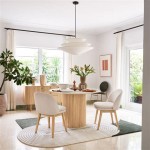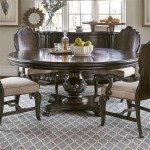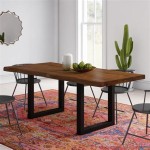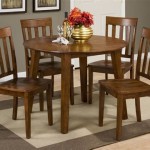Rug Or No Rug Under Dining Table: A Comprehensive Guide
The question of whether to place a rug under a dining table is a complex one, with no definitive answer universally applicable to all homes. The decision hinges on a variety of factors ranging from aesthetic preferences to practical considerations such as floor type, lifestyle, and the overall design scheme of the dining area. A rug can significantly impact the look and feel of a dining space, adding warmth, texture, and visual interest. Conversely, omitting a rug might be the more sensible choice in certain situations, simplifying maintenance and highlighting existing architectural features.
Understanding the advantages and disadvantages of using a rug under a dining table is crucial in making an informed decision. This involves carefully weighing the potential benefits against the potential drawbacks, considering the specific circumstances of the dining area, and evaluating personal priorities regarding style, practicality, and maintenance. This article aims to provide a comprehensive overview of the key considerations involved in determining whether a rug is a suitable addition to a dining space.
Aesthetic Considerations: Enhancing Visual Appeal
One of the primary reasons people choose to place a rug under a dining table is to enhance the aesthetic appeal of the space. A well-chosen rug can serve as a focal point, drawing the eye and anchoring the dining area within an open-plan living space. It can also contribute to defining the dining area as a distinct zone, creating a sense of separation and visual order. The color, pattern, and texture of the rug can complement the existing decor, tying together the various elements of the room and creating a cohesive and harmonious design.
The rug can also be used to introduce new colors or patterns into the dining area, adding a touch of personality and visual interest. For instance, a brightly colored rug can inject energy and vibrancy into a neutral-toned room, while a patterned rug can add depth and complexity to a minimalist design. The choice of rug material can also impact the overall aesthetic, with plush wool rugs offering a luxurious and inviting feel, while natural fiber rugs like jute or sisal providing a more rustic and organic look.
The size and shape of the rug are also critical considerations in achieving the desired aesthetic effect. A rug that is too small will make the dining area feel cramped and disjointed, while a rug that is too large might overwhelm the space and detract from other design elements. As a general rule, the rug should be large enough to accommodate all chairs when they are pulled away from the table, ensuring that the chair legs remain on the rug even when occupied. The shape of the rug should ideally mirror the shape of the dining table, creating a sense of visual balance and harmony.
Practical Considerations: Protecting Floors and Reducing Noise
Beyond aesthetics, a rug under a dining table offers several practical benefits. One of the most significant is floor protection. Dining areas are often high-traffic zones, and the constant movement of chairs can cause scratches and wear on hardwood, tile, or laminate floors. A rug acts as a barrier, absorbing the impact of chair legs and preventing damage to the underlying flooring. This is particularly important in homes with delicate or expensive flooring materials.
Another practical benefit is noise reduction. Hard floors tend to amplify sound, making dining areas prone to echoing and clattering. A rug can help to dampen sound, creating a more comfortable and inviting atmosphere for conversation. The soft fibers of the rug absorb sound waves, reducing noise levels and minimizing distractions. This is particularly beneficial in open-plan living spaces where noise can easily travel between different areas.
A rug can also provide added comfort underfoot, especially in homes with hard floors. Standing or sitting for extended periods on a hard surface can be tiring and uncomfortable. A rug provides a softer and more cushioned surface, making the dining experience more pleasant. This is particularly appreciated during long meals or gatherings where guests spend a considerable amount of time seated at the table.
However, it's important to acknowledge the practical challenges associated with having a rug under a dining table. Namely, it adds another surface to clean and maintain. Food spills are common in dining areas, and rugs can easily become stained or soiled. Regular vacuuming and occasional professionalCleaning are necessary to keep the rug looking its best. The choice of rug material should also be carefully considered, opting for stain-resistant and easy-to-clean options whenever possible. Darker colors and patterned rugs can also help to conceal minor stains and imperfections.
Lifestyle and Maintenance: Minimizing Cleaning Efforts
Lifestyle plays a significant role in determining whether a rug is a suitable addition to a dining space. Families with young children or pets might find that a rug requires more maintenance than it's worth. Spills, crumbs, and pet hair can quickly accumulate on the rug, necessitating frequent cleaning. In such cases, opting for a rug that is easy to clean and stain-resistant is essential, or perhaps forgoing a rug altogether might be the more practical choice.
Conversely, individuals or couples who dine out frequently or maintain a more minimalist lifestyle might find that the maintenance requirements of a rug are minimal. In these situations, the aesthetic benefits and comfort it provides may outweigh the occasional cleaning efforts. The frequency and intensity of dining activities should be carefully considered when making the decision about whether to include a rug.
The choice of rug material is also crucial in minimizing cleaning efforts. Synthetic rugs, such as those made from polypropylene or nylon, are generally more stain-resistant and easier to clean than natural fiber rugs like wool or cotton. These synthetic materials are less absorbent and can often be cleaned with a simple spot treatment. Natural fiber rugs, on the other hand, may require professional cleaning to remove stubborn stains or odors. The weave of the rug also affects its ease of cleaning, with tightly woven rugs being more resistant to spills and dirt than loosely woven rugs.
Consideration must also be given to the underlay. A quality rug pad is essential for prolonging the life of the rug and protecting the flooring beneath. It also provides added cushioning and helps to prevent the rug from slipping, reducing the risk of accidents. Furthermore, some rug pads are specifically designed to be moisture-resistant, preventing spills from soaking through to the floor below. Investing in a good quality rug pad is a wise decision that can significantly enhance the overall experience of having a rug under a dining table.
Ultimately, the decision of whether to place a rug under a dining table is a personal one that depends on a multitude of factors. Evaluating the aesthetic preferences, practical considerations, and lifestyle-related impacts is essential in making an informed choice. By carefully weighing the potential benefits against the potential drawbacks, individuals can create a dining space that is both visually appealing and functionally practical.
The style of the space is another important detail. If the room is formal and designed for upscale dining, a rug would be more favorable. Casual spaces might not require this addition. It's also important to note the foot traffic. If many people often walk through the dining space, a rug could present an issue and require more frequent cleaning. Also, if the space is used often and regularly, the rug would need to be vacuumed often. If that doesn't fit into the lifestyle, a rug would not be a good choice.
Also note, that when making this decision, it's always best to consult with an interior designer professionally to make sure the best decision is being made. There are many factors that could be overlooked when designing a room, and consulting a professional can help in achieving the best results. Their expertise may provide a different outlook during the design process and will make the process much more streamlined.

Dining Room Rug Dilemma Should You Have One

Rethinking Area Rugs For Dining Rooms Addicted 2 Decorating

Rug Or No Under Dining Table

Dining Room Rug Dilemma Should You Have One

Rethinking Area Rugs For Dining Rooms Addicted 2 Decorating

Rethinking Area Rugs For Dining Rooms Addicted 2 Decorating

No You Don T Need A Rug These Homes Are Proof

Rethinking Area Rugs For Dining Rooms Addicted 2 Decorating

Rethinking Area Rugs For Dining Rooms Addicted 2 Decorating

Should You Put A Rug Under Dining Table Furniturebox Uk








